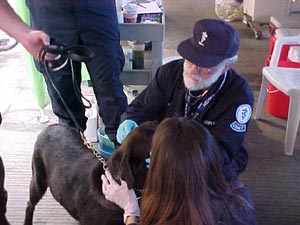VMATs aid rescue efforts in New York City
|
Sept. 26—Dr. Barry Kellogg has witnessed the terrible power of nature firsthand. In September 1995, he was part of the relatively new Veterinary Medical Assistance Team deployed to assist relief efforts in the U.S. Virgin Islands in the aftermath of Hurricane Marilyn. Four years later he was activated when Hurricane Floyd pounded the coastlines of the Carolinas and much of the eastern seaboard.
But nothing prepared the Massachusetts practitioner for the destructive force man was capable of unleashing. "I have never, ever seen, nor been involved in, anything like this," Dr. Kellogg said about the devastation where the World Trade Center's twin towers stood until Sept. 11. Soon after the attack, the Federal Emergency Management Agency dispatched VMAT-1, one of four regionally based teams, to provide medical care for 40 of the agency's urban search-and-rescue dogs sent to locate survivors. Dr. Kellogg, VMAT-1 commander, explained that his team was nearest to the city and could deploy the quickest, since all air travel had come to a halt. Veterinary services were first incorporated into the Federal Response Plan for disaster relief with the signing of a memorandum of understanding between the U.S. Public Health Service and the AVMA in 1993. The AVMA sponsors the VMATs and funds the teams through a grant from the American Veterinary Medical Foundation. Comprising approximately 120 veterinarians, veterinary technicians, and support personnel, the VMATs perform duties that range from providing veterinary care to monitoring for animal and zoonotic diseases and other public health problems. The veterinary personnel are trained and equipped to respond to large-scale disasters like that in New York City, but can also handle disasters of limited scope, such as floods and hurricanes.
After arriving in New York, Dr. Kellogg operated out of the Stewart Air National Guard Base in Newburgh as part of the Mission Support Team, which orchestrates the Public Health Service's disaster response. His job was to determine the needs of the canine units and to develop a plan of action. Dr. Kellogg explained that his dual role with the Public Health Service and FEMA is unprecedented in that the two federal agencies called upon the VMAT directly. "This is groundbreaking in the sense VMAT deployed across the two [agencies], which is a great accomplishment for the veterinary profession," he said. In previous disasters, FEMA has authorized activation of the VMATs in response to a request from officials of the affected state. By Wednesday most of his approximately 15-member VMAT-1 had assembled, and they soon established three canine triage stations at the World Trade Center. Their primary goal was to care for the FEMA canine units, but Dr. Kellogg said the mission quickly expanded to providing medical care for any search-and-rescue dog needing treatment.
The VMAT coordinated its efforts with the scores of local veterinarians working at the animal hospital van dispatched by the Suffolk County, N.Y., Society for the Prevention of Cruelty to Animals. Many of the veterinarians have been providing medical care to the canine units since the day of the attack. The VMAT established a station in the Jacob Javits Convention Center, where the canine units are being housed. It is an ideal location for providing care to teams resting there. "If they had minor issues, things not of an acute emergency nature, but that needed to be addressed before they went back to work the next day, we could provide that service," Dr. Kellogg said. The canine units, he explained, aren't accustomed to having on-the-spot veterinary care. So once word got out, the number of cases rose significantly, the highest number within a 24-hour period reaching 107 visits. The VMAT also operated a mobile triage unit at ground zero. The compact, two-person flatbed allows for rapid stabilization and evacuation of seriously injured dogs, although it hasn't been necessary, Dr. Kellogg said. Early on, conditions at ground zero were dangerous and chaotic. The air was thick with dust, smoke, and debris. Nearby buildings, damaged by the explosions, were collapsing. The Federal Bureau of Investigation had declared the area a crime scene, complicating rescue efforts. The determination was made, however, that the search for survivors was more important. There was no central command area coordinating the many medical personnel and volunteers who descended on the site. What's more, the news media, in search of a positive angle to the tragedy, were swarming the canine units and veterinarians for interviews and photos. Security is much tighter now, Dr. Kellogg explained, and the flow of people into the area is limited. "Every disaster takes on a life of its own," he said. "And this one, being so big and chaotic initially, it just takes a while before it comes under control." After two weeks at the World Trade Center, Dr. Kellogg and the other members of VMAT-1 are being replaced with several members of VMAT-2. There's no indication how long their services will be needed, but FEMA has indicated that VMAT members will be there as long as dogs are searching the piles of rubble for the more than 5,000 human casualties. "We as veterinarians and technicians on these VMAT teams have gotten a chance to contribute something," Dr. Kellogg said. "It's our chance to do something. It's our chance to help out the U.S. and the people and the families and everybody involved, by doing something." On Sept. 24, two VMAT members were relocated to Staten Island, N.Y., where canine units are searching the rubble removed from Manhattan. When the operation moves into the recovery phase, Dr. Kellogg said, most of the work will be transferred there. But no public official is ready to reclassify the mission from "search and rescue" to "recovery," even though it's been more than two weeks since the attacks. "Technically," he said, "it's still a search and rescue." | ||||

